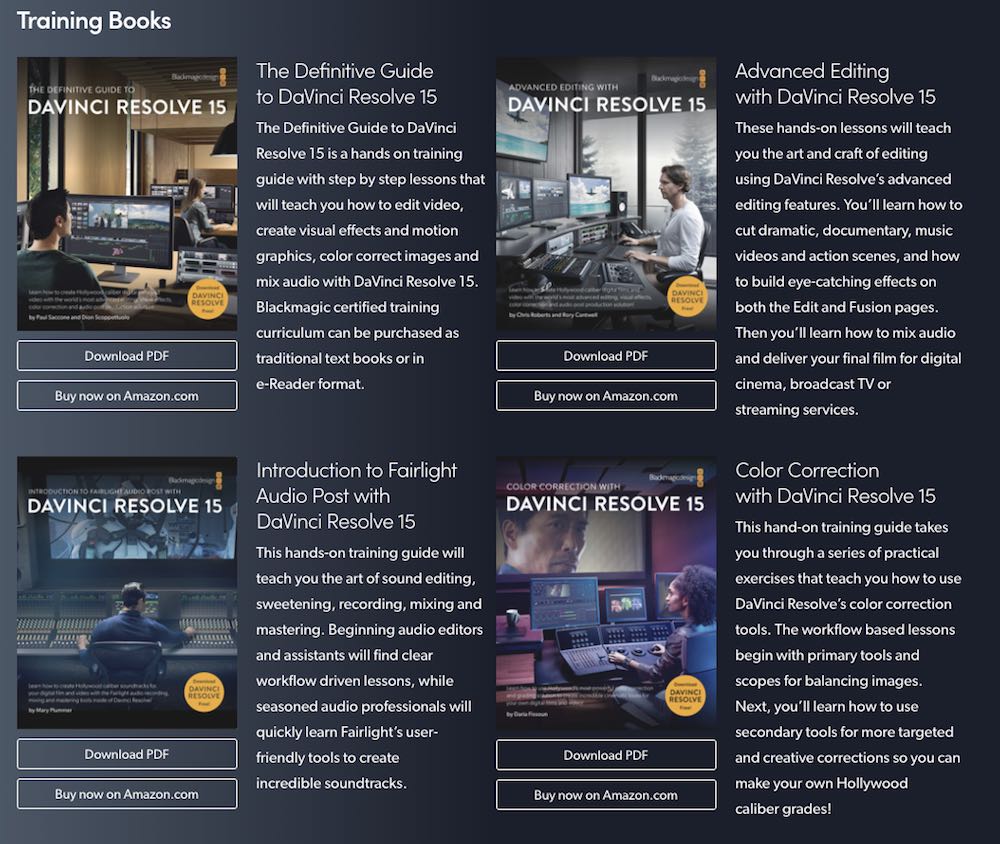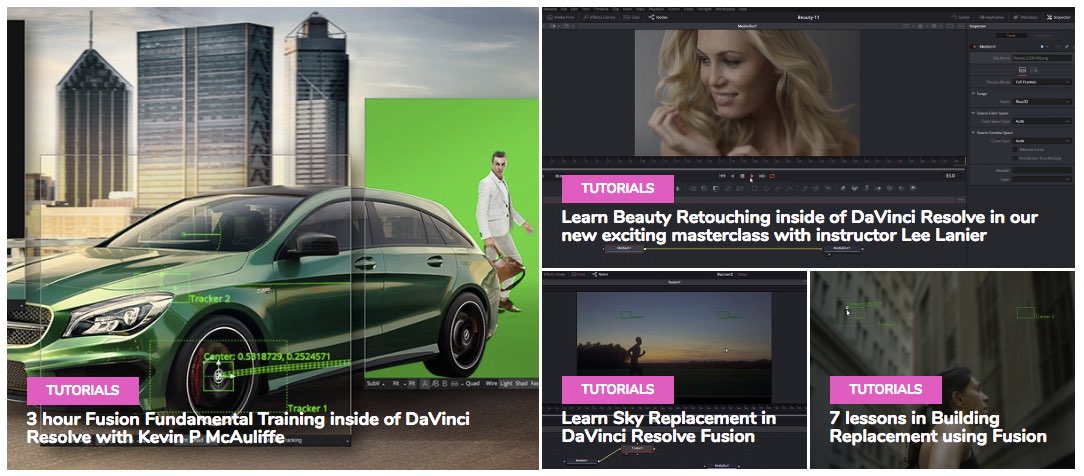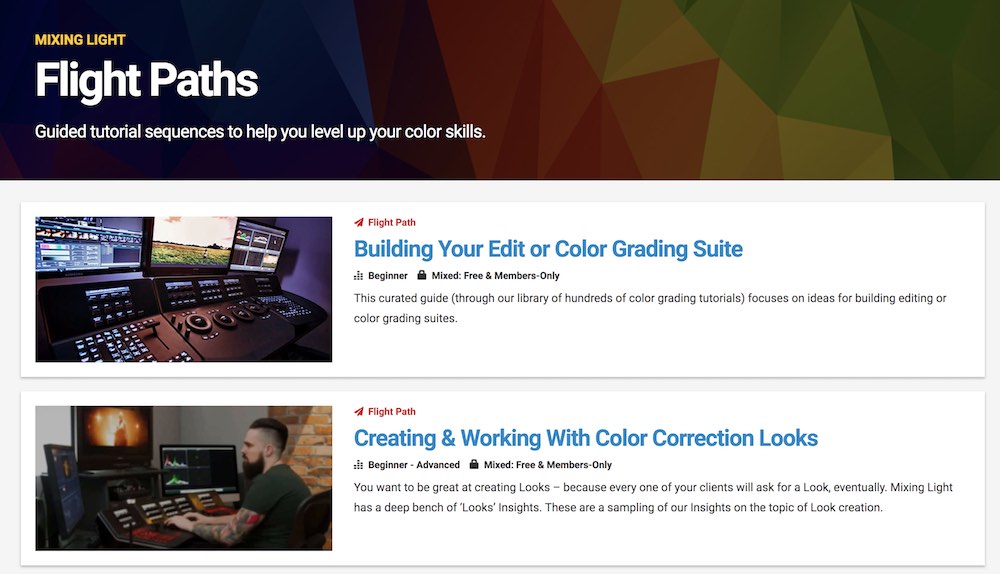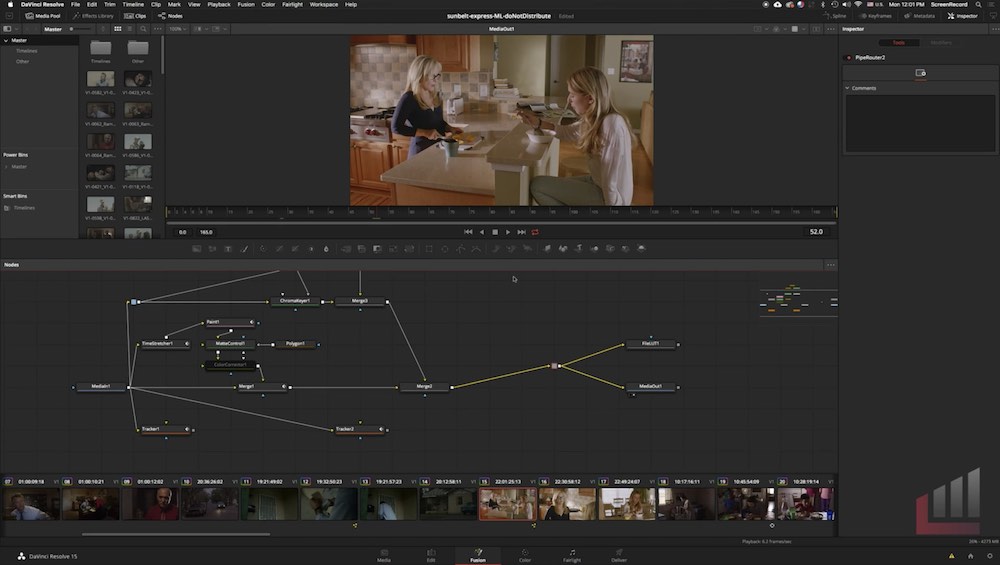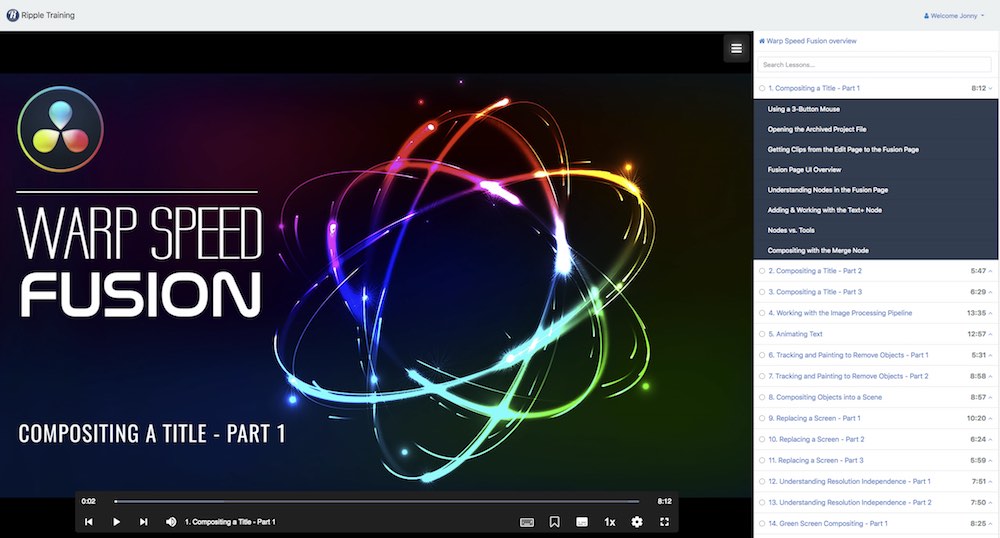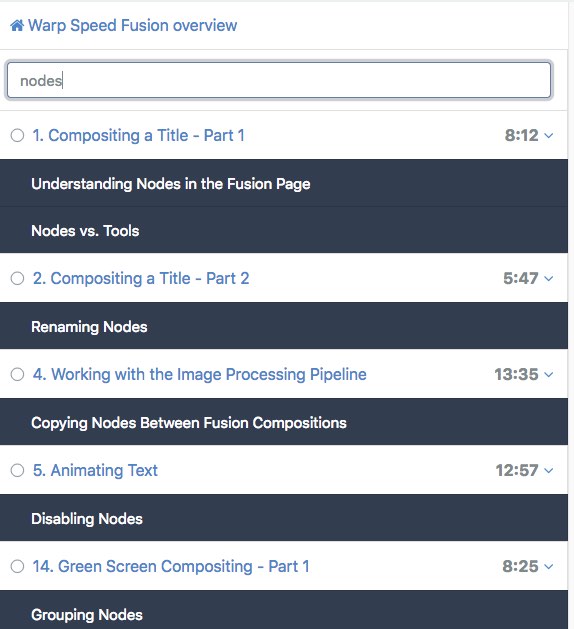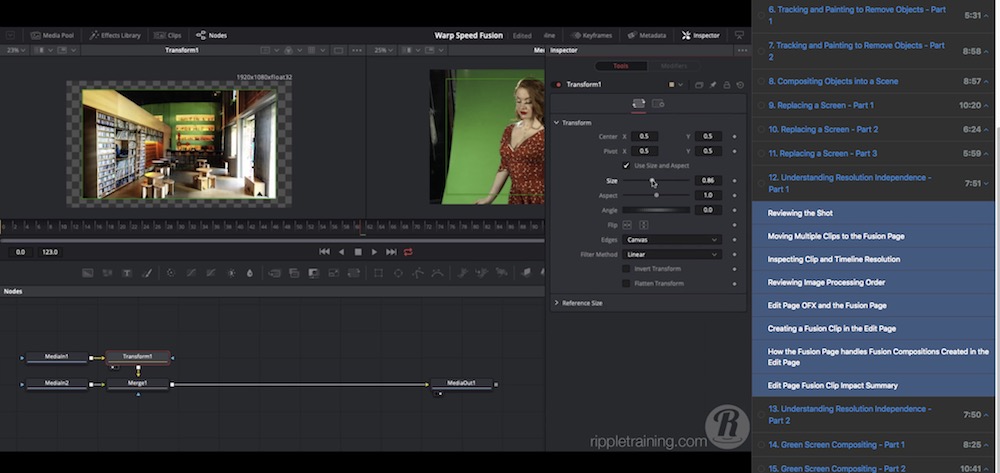Learn High End Finishing Techniques in DaVinci Resolve Fusion
Last updated – May 2021
The inclusion of Fusion in DaVinci Resolve has made the opportunity to learn high end finishing techniques, allowing you to add a higher level of creative polish and deliver greater value to your clients all the more accessible.
But where should you go to learn how to perform tasks such as virtual set extensions, object removal and clean up, multi-pass composites, complex sky replacements, or 3D camera moves, text animation and particle effect systems?
Well, that’s what this post is all about. I take an inside look at some of the key places to learn more about working in Fusion, DaVinci Resolve’s colour grading pipeline and After Effects to develop a deeper skillset as a film editor. Hopefully this will give you a better sense of what you’ll get and where you can get the best return for your investment, depending on what you’re looking to achieve.
For a TLDR summary, those sites are:
- LowePost – Stupidly good value at less than $7 a month for a growing wealth of training!*
- Mixing Light – The professional colorists choice for community and career development
- Ripple Training – An excellent online training provider with unique features and crystal clear, effective teaching
- FXPHD – A VFX nerd’s nirvana with over 1300 hours of expert training available for a plethora of professional applications
I’m sure there are other courses out there, but these are the best paid-for training options I know of right now for Fusion in Resolve.
Also hopefully it goes without saying that you can download the fully functionally, feature-packed free version of DaVinci Resolve here.
*February 2020 update – LowePost Discount Code
To celebrate the launch of their exciting new advanced course on Professional Colour Grading Techniques and Look Development, LowePost are offering an early bird discount of 10% off the cost of an annual subscription with the code: “eb2020“
This offer won’t last long, so seize it while you can!
Traditionally this kind of would most often be done by an online editor of VFX artist, and I’m sure that’s very much still the case where budgets allow, although my assumption is that, increasingly, colorists and editors might be expected to do these kind of things themselves, especially when the tools are right there in front of them.
If you want to learn more about what an online editor does at a Hollywood post-house, check out this previous interview with Trailer Park Online Editor VK Shah.
Learning DaVinci Resolve Fusion for Free
If you’re after some free training on Fusion then there are many valuable resources out there, including from Blackmagic Design itself.
This recent post rounds up over 8 hours of free training covering every stage of post production within DaVinci Resolve, including an hour and a half of introductory training from editor and VFX artist, Tony Gallardo on using Fusion.
Further Fusion related posts on the blog, packed with free training, include:
- DaVinci Resolve 15 Tips and Training – Including an excellent VFX breakdown from Tony and colorist Juan Salvo.
- The Best Post Production Presentations from NAB 2018 – Learn how Red Sparrow editor Alan Bell uses Fusion in his workflow
- Getting Started with Fusion in DaVinci Resolve 15
- Getting Started with Fusion 9
- DaVinci Resolve 14 Colour Grading Tutorials
One thing that is clear is that half of the battle of getting to grips with Fusion is learning the name and function of each of it’s tools. To that end you might want to leaf through the 645 pages (Part 7, Fusion Page Effects) dedicated to that task in the 2,632 page DaVinci Resolve 15 manual.
Download Every DaVinci Resolve Training Book for Free
You can now download all four of Blackmagic Design’s training books in PDF form for free, from their website, or if you prefer buy them in hardcopy or ebook format from Amazon.
Currently there are four titles available:
The Definitive Guide to DaVinci Resolve 15 by Paul Saccone and Dion Scoppettuolo (395 pages)
Advanced Editing with DaVinci Resolve 15 by Chris Roberts and Rory Cantwell (374 pages)
Introduction to Fairlight Audio Post with DaVinci Resolve 15 by Mary Plummer (425 pages)
Color Correction with DaVinci Resolve 15 by Daria Fissoun (322 pages)
Download them today!
LGG Forums
It’s also worth mentioning the excellent, and free Lift Gamma Gain forums, which are always a hot-bed of discussion from a global community of professional and aspiring colorists. The forum covers everything from industry news and opportunities, to a dozen threads on all the major tools, plus the usual hardware suggestions and troubleshooting back and forth.
It’s well worth signing up to learn from and contribute to Lift Gamma Gain.
LowePost – A Growing Community of Post Artists
The team behind LowePost have determined to make it the best creative online learning platform for editors, colorists and finishing artists around, with a huge expansion of both their training resources and their instructor base, adding well-known names like Lee Lanier, Rony Soussan and Kevin P McAuliffe to their roster.
LowePost is a highly affordable subscription site which costs just $79 USD a year, which works out to only $6.5 a month! For this price you get full-access to all of their training courses, downloadable project files, colour grading case studies from some of the world’s best colorists, and written articles (insights) on all aspects of the craft.
If some of that sounds a bit run of the mill, then you’re missing the fact that you can watch over the shoulder of Company 3 colorist Tyler Roth in a commercial grading session, read a breakdown of the colour grade on The Hobbit trilogy from the colorist who graded it (Trish Cahill) or work through a 1500 word master study in using Printer Lights in DaVinci Resolve with contributions from eight different colorists including Walter Volpatto (The Last Jedi, Dunkirk) and Florian ‘Utsi Martin (Independence Day: Resurgence, The Lord of The Rings trilogy).
Luma curves are one of my favourite tools to use in achieving a richer, bolder look.
By grabbing a still of how a shot sits with the desired exposure levels etc and playing with the curve in conjunction with Lift Gamma Gain, you are able to get some extra tone into areas of the picture that the standard tools can’t reach alone.
Often you end up in the same place as your still with no perceivable difference, but sometimes, with enough experimenting, you can come up with some beautiful richness and depth and still keep the same exposure level to what you started with and desired in the first place, just a much richer frame in certain subtle areas. This doesn’t always work so you have to be judicious. – Trish Cahill on grading The Hobbit
Other Case Studies discussed by the original colorist include films such as; Saving Private Ryan, Grand Budapest Hotel, Band of Brothers, Mad Max: Fury Road, Life of Pi, Sully, Romeo & Juliet, The Equalizer and about 40 more!
There are also colour grading insights on working in Assimilate Scratch and Baselight, so the site isn’t entirely DaVinci Resolve-centric.
LowePost’s recent and unmatched expansion into video tutorial courses include:
**NEW** – Professional Colour Grading Techniques and Look Development in DaVinci Resolve – 18 advanced lessons presented by Kevin P. McAuliffe but based on the contributions made by a whose-who roster of professional colorists including Paul Ensby (Romeo & Juliet, Kingdom of Heaven) Jim Passon (Avatar, Titanic, Jurassic Park, Pleasantville, Transformers), Florian ‘Utsi’ Martin (Lord of The Rings, Independence Day) and many other top colorists listed here.
This new course is a step up from the other training offered by LowePost, in terms of the level of ability and craft expected of the colorist in question.
The main concepts discussed in the course are advanced contrast management, balancing techniques and look development. The focus is primarily on higher end colour grading, colour theory and teaching techniques that took professional colorists years of experience to master.
I’ll be doing an in-depth review of this exciting new course very soon!
NEW – Four Motion Graphics courses on HUD element design using Cinema 4D and After Effects from popular instructor Nick Harauz. Learn in detail how to create HUD style landscapes, globes, hexagon and Mixamo animations.
NEW – Introduction to Visual Effects in After Effects – Lee Lanier delivers 37 lessons aimed at anyone new to After Effects, covering VFX staples such as masking, tracking, compositing and object removal.
3D Environments in DaVinci Resolve Fusion – Over 18 short lessons Lee Lanier demonstrates “how to set up a basic 3D scene, add and import models, assign materials and textures, add and adjust lights, and how to combine to the 3D scene with 2D parts of the Fusion flow.“
Chroma Keying in DaVinci Resolve Fusion – Lee Lanier teaches advanced techniques across 13 lessons to help you “solve complex shots with poorly lit green-screens, spill issues, fine details, reflections, tracking marks, soft lenses, and much more.“
Rotoscoping in DaVinci Resolve – 16 lessons from Lee Lanier on the best practices for effective rotoscoping, using everything from power windows to custom masks in Fusion. The courses escalates from the foundational basics through to advanced techniques.
Fairlight Essentials – Kevin McAuliffe delivers 4 hours of training to help you get to grips with the Fairlight page in DaVinci Resolve, including recording voice over, applying limiters, compressors and EQ and managing your mixes with busses and bounces.
DaVinci Resolve Paint Fixing is a new 11 lesson short course taught by Lee Lanier using both the Color and Fusion pages to teach you “the invisible art of removing unwanted objects and improving shots.” You’ll learn how to use the Patch Replacer, masks, planar tracking and animated strokes in Fusion to perform common VFX tasks such as object removal and shot clean up, giving you an edge as an editor or colorist to bring an extra level of polish to your projects.
Editing in DaVinci Resolve 16 – With 6 hours of training from Kevin P. McAuliffe this is the most extensive training on editing in Resolve 16 available online today and includes a 3-part lesson on using the new Cut Page. There are also 27 other lessons on everything from import through to DCP creation (Studio only), as well as working with 5.1 audio, text and motion graphics, round-tripping to After Effects and Pro Tools and much, much more.
Colour Management Workflow in DaVinci Resolve – 11 lessons from Lee Lanier on the more technical side of colour grading including ACES, colour space transforms, using DCTLs, multiple colour space outputs and a whole lot more.
Introduction to Visual Effects in DaVinci Resolve – Lee Lanier delivers 36 new insights on performing tasks outside the scope of the ‘Essential training’ course, covering topics such as optical light and light effects, 2D/3D tracking, paint fixing/artefact removal, rotoscoping for colour correction, warping and morphing, chroma keying and much more.
Fusion Essential Training – 3 hours of introductory training to help you get up to speed on working with in a node-based compositing environment and achieving some basic tasks.
Fusion Background Replacement Masterclass – Motion tracking, stabilisation, rotoscoping and compositing are all covered in this 7 lesson course from Lee Lanier.
Sky Replacement in DaVinci Resolve Fusion – Lee Lanier delivers the course you can preview in the teaser trailer above, on motion-tracking and replacing a sky in Fusion.
Advanced Techniques for Background Clean Up in After Effects – Learn highly transferable skills from Lee Lanier such as keying, masking and tracking to perform effective background clean up.
DaVinci Resolve Beauty Retouching – Something every colorist is asked to do, including blemish clean up, flyaway hair removal, skin softening and much more.
Conforming in DaVinci Resolve – 5 hour training course from Kevin P. McAuliffe, on ingesting, conforming and delivering a project from Avid Media Composer, Adobe Premiere Pro and Apple Final Cut Pro X.
Creative Looks in DaVinci Resolve – An ‘in progress course’ that will be updated over time, it’s focus is on re-creating specific grades in Resolve, which kicks off with the classic, bleach by-pass look.
SCRATCH Essential Training – A 15 lesson course from Kevin P. McAuliffe on getting started with Assimilate SCRATCH. You can also pick up 20% off SCRATCH and 3-months of free access to the course, with this link, for a limited time.
Dailies in Assimilate Scratch – This 7 lesson short course from Kevin P. McAuliffe demonstrates how to correctly create dailies including project set up, audio-syncing, applying LUTs and managing all your metadata.
Each course comes with downloadable project files and assets so that you can follow along at home.
All for less than $5 a month, plus all the new content that is yet to be added on a regular basis, throughout your subscription.
Anyway, hopefully that gives you a sense of why it’s a bit of a no-brainer to subscribe to LowePost, especially when you can lock in a life-time price when you do.
Even if you don’t want to spend a penny you should sign up to LowePost anyway, to access their vibrant, and free, discussion forums which includes threads on editing, colour grading and finishing as well as all the usual topics of hardware recommendations and troubleshooting questions, reel showcases and feedback, and even job offers.
LowePost have recently released this clip, from their 5 hour conforming in DaVinci Resolve course, on how to fill in any gaps created by offline media in your conformed timeline, using an offline reference movie. The lessons in this course are being released on a weekly basis.
Fusion Training on LowePost.com
I thought I’d take a closer look at two of the Fusion training courses, Fusion Essential Training and Lee Lanier’s Sky Replacement in DaVinci Resolve Fusion.
This free sample lesson (above) from Kevin P. McAuliffe’s three hour foundational training on Fusion, which runs for a full 18 minutes and covers working with 3D text, will give you a taste of what’s on offer.
Fusion Essential Training – Kevin P. McAuliffe
- Understanding the Resolve/Fusion workflow
- How do nodes work?
- Animating with Keyframes
- Understanding masks
- Working with the merge tool
- Creating texts and titles
- Mastering the transform node
- Basic 3D
If you’re an editor whose already comfortable with working in DaVinci Resolve 15 then this 10-part course will help you get up to speed on adding Fusion to your toolkit.
While this assumes that you know a little bit about Resolve, Kevin covers all of the topics in the course in substantial depth and makes sure to explain all of the concepts and processes that might be happening under the hood in DaVinci Resolve while you’re working.
In the first lesson one of the most important take-aways for successfully navigating a node-based workflow is keeping your node tree organised and clearly labelled, as you work. Always tidy as you go.
The shortcut for renaming a node is F2 in the standard Resolve keyboard shortcut set up. One thing I appreciate from all of Kevin’s tutorials is that he calls out the shortcuts for both Mac and PC users, for an inclusive listen.
Each lesson runs for around 10-20 minutes, which still makes them easy to digest whilst giving you a solid over view of each topic without stopping. Kevin also mixes in numerous relevant ‘mini-lessons’ on things like the UI navigation tips as he goes along, which helps you to pick up a few extra pointers as you go along.
As the training on LowePost is often released one week at a time, there’s also a strong feedback loop for members to comment on the lessons and request topics they’d like to see covered in the forums. You’ll then see answers to these in some of the later lessons.
Now that all 10 parts have been released you could choose to watch the 10th lesson first, to get a sense of where you will end up having taken the course, as this lesson brings all of the learning from the previous training together in one tutorial.
Kevin is a fantastically articulate trainer, and importantly he’s easy to listen to (which is not true of all trainers out there) for extended periods.
If you’re an editor looking to get a few simple things done inside of Fusion and enjoy activity-based tutorials (actually making something) then this is an ideal place to start. Once you’ve gotten these concepts firmly in hand, you’ll be in a good place to absorb some of their more advanced training as it is released.
To my mind it’s the addition of comprehensive courses like these that give LowePost a huge edge over some of the other sites in this post, when it comes to value for money.
Take a look at Fusion Essential Training for yourself here.
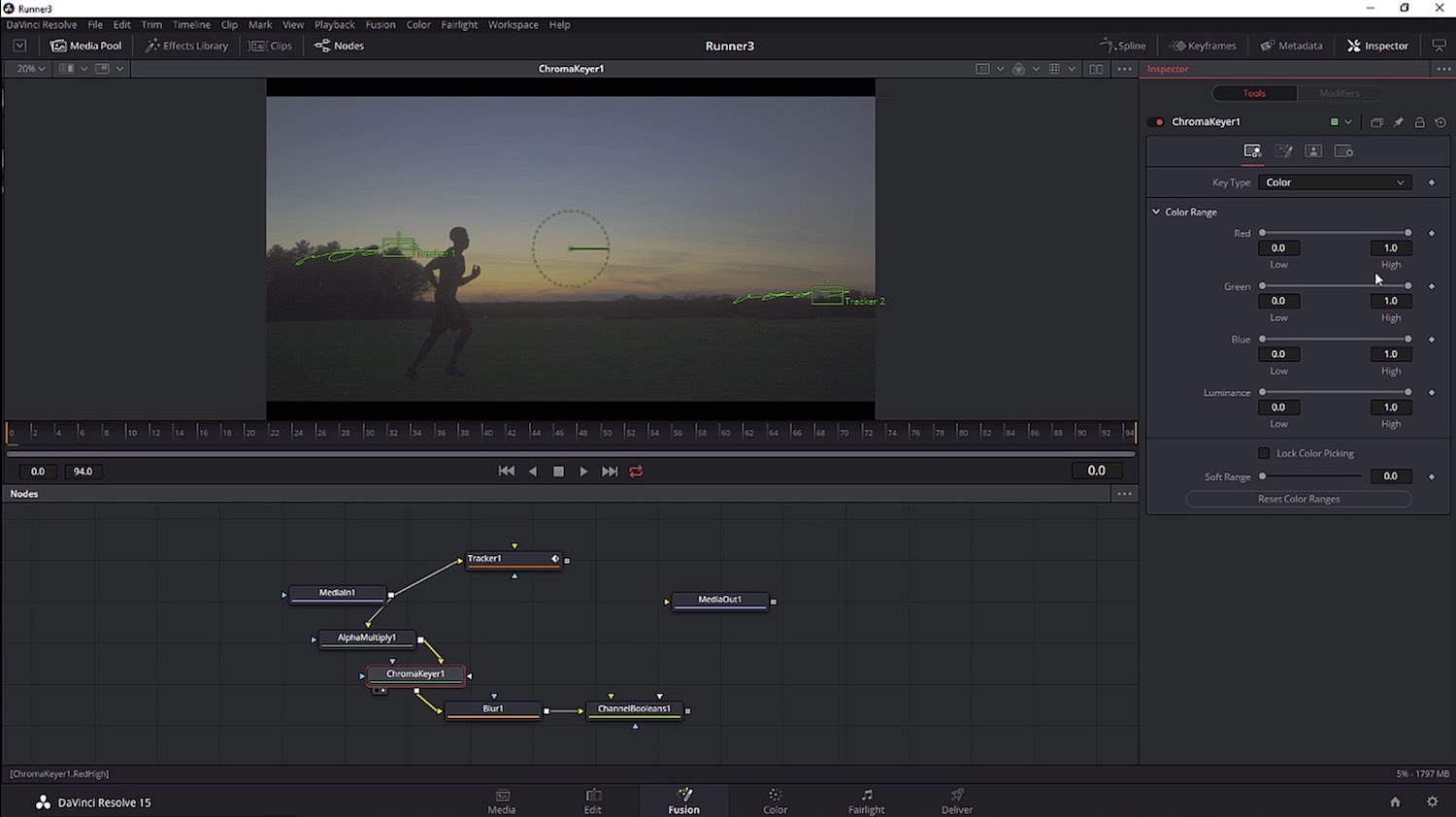
Sky Replacement in DaVinci Resolve Fusion
- Motion tracking
- Keying techniques
- Inserting sky in the background
- Adding grain
- Simple color correction
Lee’s delivery style is straightforward and is largely quite ‘step-by-step’ in terms of describing how to replicate his steps at home, although he does frequently describe why he’s doing what he’s doing.
If you’re brand new to Fusion you’d be best placed to start with the Fusion Essential Training course first, just to help establish the concepts, tools and workflow processes in your mind before diving into a specific task like sky or building replacement.
In this sky replacement tutorial series Lee uses a Luma mask to separate the runner from the background, instead of rotoscoping him, which works well and teaches you an effective alternate approach.
Lee offers some really helpful tips along the way, including using Tracker flick-books, working around some of Resolve 15’s bugs and the importance of thinking ahead in a node-based workflow.
The lessons in Lee’s sky replacement course are all under 5 minutes which means you can easily absorb the whole course in under half an hour, which is actually a huge benefit when you need to learn something specific, quickly and don’t want to be intimidated by a multi-hour marathon.
Each short lesson focuses on a single step of the process, which also makes it easier to re-watch specific steps at a later date, rather than scrubbing through an hour of content trying to find the spot you need.
The LowePost training web pages aren’t anywhere as advanced as, say, those of the Ripple Training online player, but then again none of the other training sites are!
Either way, it’s entirely functional and efficient and all the videos are delivered in a nice high quality 1080p, which made it easy to see detailed adjustments to things like film grain, motion blur etc. without any compression artefacts obscuring what is going on.
While sites like Mixing Light allow you to download the training and weekly insight videos, LowePost’s are online only, as a way to adhere to their licensing terms and attempt to curb piracy.
Given that I’m online 99% of the time this isn’t a problem, other than competing against my latent desire to squirrel things away on a hard drive somewhere, instead of entrusting them to the cloud.
If you take nothing else away from this review it should be that you should definitely check out LowePost for yourself, as it’s more than worth subscribing at less than the price of a Cronut a month.
Mixing Light – An Essential Colorist (Subscription) Community
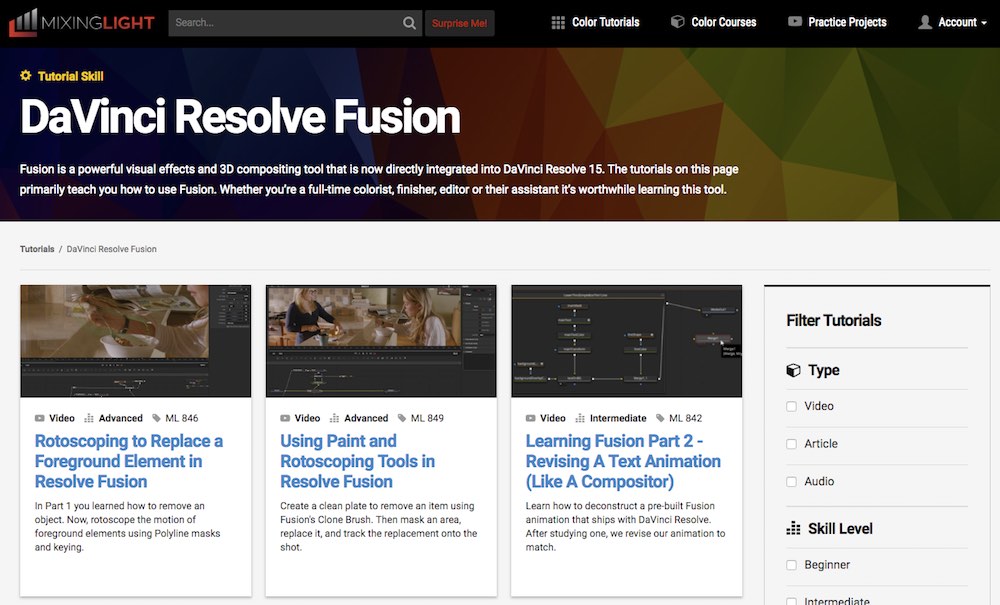
Mixing Light.com was founded by three professional colorists, two Americans and an Irishman, (there has to be a good joke there…) in 2013 and has since grown into a huge library of over 500 video tutorials, nearly 200 articles, and close to 100 podcasts, which is added to each and every week from a roster of 15 contributing colorists.
Every month you can expect to see 6 – 12 new pieces of content released on a regular basis. The exact number and mix of video, text and audio articles will vary from month to month. The exact release schedule will also vary from week-to-week and month-to-month.
It has also become a vibrant community of post production professionals from around the world who all share ideas and techniques, comment voraciously on individual insights and advise younger colorists as needed. There’s also a wide range of skill-levels and career focuses too, from commercials and features through to documentaries, music videos and beyond.
If you’re a premium member you have immediate access to everything and can even download the insight videos and audio content (something you can’t do on Lowe Post), or you can go ‘streaming only’ if you prefer, although it’s actually better value to go premium ($244 vs $288 total a year) but you’ll need to pay in bigger instalments (3 months/annually vs monthly).

Mixing Light differs from a site like Lowe Post, in that the stand alone training courses aren’t included in the subscription price, but you can usually buy them at a discount if you’re a member. These training courses are much longer and far more in-depth than Lowe Post’s current offerings. For example, the complete Resolve course taught on v12.5 ran to nearly 26 hours!
More recently Mixing Light’s DaVinci Resolve 14 Blackmagic Design certification training course runs to just shy of 14 hours.
Mixing Light also has complete practice projects from which you can download the original source material and conformed timelines to work with, which I’ve talked about in more detail here.
If you want to try Mixing Light for yourself they offer a streaming only 7 day free trial, which you can binge to your hearts content. They also regularly offer free training insights, so it’s worth checking in again every now and then even if you’re not a subscriber.
I’ve updated this previous post, to include every free insight available to date, which involved adding in over 30 new free insights!
Highlights of some recent free insights include:
- The 2018 Mac Mini – Perfect Color Suite Companion?
- Creating A Western Look With A Color Space Transform And Film Emulation LUT
- Permanently Adding LUTs To The Lumetri Color Panel: 2018 Update
- Evaluating LUTs with a Stress Test
- Resolve 15 New Color Page Features
- Top Calibration and Display Setup Questions (with Bram Desmet)
- Colorist Podcast EP 020: Ian Vertovec – Fincher’s colorist
- The Challenges (And Lessons Learned) Of Color Restoring Classic Films
Some of the welcome improvements that came in version 2.0 of the site, were the new ways to tame the huge archive of teaching through the introduction of things like Flight Paths (playlists) which guide you through the content focused on a particular topic such as building your own grading suite, or working with LUTs.
Here is a link to the most recent flightpath that takes you through their insights on DaVinci Resolve 15 and Fusion.
They also beefed up the search and categorisation functions which makes it much easier to find actionable information on specific topics. Again, I’ve written about that in more detail here.
I’ve previously reviewed Mixing Light several times over the years, which you can check out below, but the long and short of it is that it’s an excellent resource for any professional colorist, regardless of their experience level, who wants to add to their learning on a continuous basis.
If you’re a freelance or professional colorist you can likely make your subscription a tax deductible business expense anyway, so sign up and skill-up!
- DaVinci Resolve 14 Training Courses Reviewed – August 2017
- Mixing Light 2.0 and all their free training videos – July 2017
- Advanced DaVinci Resolve Training Reviewed – V12.5 September 2016
- Mixing Light a year in review – November 2015
- Mixing Light original review – October 2014
DaVinci Resolve Fusion Training on Mixing Light.com
Although Mixing Light doesn’t have a dedicated Fusion focused tutorial series just yet, they do have numerous insights in their Colour Library.
However I anticipate that, as with other sites, Fusion related content and training will be a growth area for Mixing Light in the coming months as more and more colorists get used to using it on a regular basis, and their clients get used to asking for the kind of solutions it can enable.
Here is a quick rundown of every currently available Fusion tutorial, at the time of writing, with the newest first:
- Rotoscoping to Replace a Foreground Element in Resolve Fusion (Part 2 Masks and Keys)
- Using Paint and Rotoscoping Tools in Resolve Fusion (Part 1)
- Learning Fusion Part 2 – Revising A Text Animation (Like A Compositor) – Part 2
- Learning Fusion The Easy Way By Using Resolve’s Fusion Text Generator – Part 1
- Introduction to Fusion’s 3D Camera – Part 2 – Auto-animate with expressions
- An Introduction to Resolve Fusion’s 3D Camera – Part 1 – False perspective with 3D camera
- An Introduction to Compositing in Fusion – FREE
- Expanding DaVinci Resolve’s Functionality with Python
- How To Paint, Track, and Replace A Logo In DaVinci Resolve Fusion 15
- An Introduction to Fusion (For Colorists) in DaVinci Resolve 15
These have been contributed to the site by a variety of different colorists including Joey D’Anna, Jamie Dickinson, Patrick Inhofer and others.
It’s also quite an eclectic list of topics, largely aimed at giving you practical examples of useful things you can achieve in Fusion – such as object removal through cloning, tracking and rotoscoping – which can sound simple enough but some of these tutorials might end up in places a touch too complex for an early learner.
As with a lot of the weekly video insights there is an assumed level of knowledge of DaVinci Resolve and the colour grading post production process, terminology and experience. Mixing Light is geared more towards users who enjoy being talked to as one professional colorist would to another.
This means that if you’re an absolute beginner you’re best place to either take one of their exhaustive multi-hour training series to get up to speed, or take a course from someone like Ripple Training.
If however you’re a working colorist or junior colorist, this is exactly the kind of teaching you want to soak up like a sponge, as this kind of ‘over the shoulder teaching’ is less and less accessible, even to assistants and juniors working on site, in todays colour grading suites, given the modern working styles and constraints faced by many colorists, clients and budgets.
So Mixing Light really is a key opportunity for accelerating your professional development as a working colorist, not least because of the excellent knowledge being shared by fellow artists, but also because of the strong sense of community and openness the site has fostered.
If you’re a professional colorist, junior colorist or editor with a passion for grading and you’re not yet signed up to Mixing Light, then you’re missing out on a very easy win!
Ripple Training – Learning the Software
Ripple Training is one of my favourite providers of instructional videos, partly because I’ve been watching them for so many years and so they feel like ‘old friends’ and partly because they are so good and delivering valuable, informative content with no fluff.
Plus their online player is second-to-none when it comes to a productive interface that does far more than just serve video content. But I’ll get to that in a bit.
Ripple Training is the one of the few entrusted places online where you can currently take Blackmagic Design Certified training, and submit the free certification exam to get your completion award. Further online providers include Mixing Light and FXPHD, among others.
Having these kinds of ‘stamps of approval’ definitely add confidence to a CV, but also taking an exam at the end of any training will give you some valuable feedback as to how much you’ve actually taken in!
When it comes to learning DaVinci Resolve in general, Ripple have several options, from a handful of different trainers.
Here are a few of the most recent courses:
- Advanced Color Grading in DaVinci Resolve 15 with Mark Spencer
- Editing & Color Grading 101 in DaVinci Resolve 15 with Spencer Meyer
- Warp Speed Fusion with Mark Spencer
- Problem Solving in DaVinci Resolve 15 with Jason Bowdach
- DaVinci Resolve 15 New Features with Alexis Van Hurkman
Courses like Alexis Van Hurkman’s exhaustive DaVinci Resolve 15 New Features training are always a worth while investment if you’re spending your working life in this app, as you’ll learn a huge amount of useful tips and time-saving tricks. Alexis originally created this training title for the original release of version 15 so this isn’t quite up to date to the latest 15.2.4 version, but it’s still excellent.
Before I get started on the actual review of the Fusion course I want to talk a bit about how excellent and well-thought out the Ripple Training online video player is. If you take a look at the image at the top of this section you can see the player with all of the controls exposed.
The player controls have all the usual things you’d expect, plus a few noteworthy extras such as; you can toggle between 1080 and 720 resolutions, playback at anywhere between 0.75x and 2x speed, toggle on/off subtitles (where available), create bookmarks and control the entire interface via keyboard shortcuts. There is even a dark mode you can toggle on if you like.
On the right of the screen you also have the chapter and sub-chapter menu, which in itself is super helpful for navigating the content, but the addition of a search function makes it all the more powerful. In the image above you can see the numerous sub-chapters of the Fusion training course that appear when you search for ‘nodes’.
One feature request would be to make all of the subtitles searchable too, such that you could pinpoint all the places in a video where the word was mentioned – although maybe this is overkill for the task of finding how to do a specific thing, and a subchapter gets you plenty close enough, and with some supporting context.
Another really valuable feature is the ability to add your own bookmarks to a video and browse through these at a later date to either refresh your memory as to key learning points, or mark where you had gotten to previously. Although I think the player does this itself anyway – like Netflix does.
The player also has some useful keyboard shortcuts including a keyboard shortcut to open the keyboard shortcuts:
- ? – Open Keyboard shortcut reference window
- K/Space – Play
- J/L – Increase/Decrease playback speed
- Left/Right Arrow – Fwd/Back 5 seconds
- Up/Down Arrow – Volume Up/Down
- M – Mute audio
- Home – Jump to the start of the lesson
- F – Toggle Full screen
- 0 – 9 – Jump to Timeline percentage
- / – Search lessons
The 0-9 numbers will jump you through a percentage of the duration of the video. So 5 will take you to the 50%/middle of the video. I guess this is handy if you want to jump through the video to find something and you can roughly remember where it is, or you could just scrub!
Although you can download the lessons to watch offline, or view them in the FCPX Extension (see this post for more on that), using the online player delivers a far superior experience. Although it is worth mentioning that the offline downloads also include the chapters and sub-chapters to navigate through in something like QuickTime player.
Another appreciated feature of the Ripple Training experience is that there are detailed breakdowns of each lesson in the ‘Outline’ section of each training title, such as in lesson 4 of their Fusion tutorial:
4. Working with the Image Processing Pipeline
- Fusion Compositions and Grading in the Color Page
- Grading in the Fusion Page
- Grading in the Color Page and Creating a Compound Clip for the Fusion Page
- Copying Nodes Between Fusion Compositions
- Grading Clips Inside a Compound Clip
- Create a Separate Text-only Fusion Composition
- Accessing Preset Fusion Title Templates
This makes it much easier to find what you’re after, especially on a ‘dip-in’ visit to refresh yourself on how to complete a specific task.
Warp Speed Fusion Training Review
The latest addition to their Warp Speed line, the 2 hour and 20 minute Warp Speed Fusion tutorial from Mark Spencer, is aimed at getting an absolute beginner up to speed in Fusion with maximum efficiency.
It’s Ripple’s first Fusion focused training title so it will be interesting to see where they take things from here, but the Warp Speed tutorial covers:
- Compositing a Text Title
- Working with the Image Processing Pipeline
- Animating Text
- Tracking and Painting to Remove Objects
- Compositing Objects into a Scene
- Replacing a Screen
- Understanding Resolution Independence
- Green Screen Compositing
The course also comes with over 1.2 GB of practice media to download and use follow along.
My goal in this tutorial is to get you using fusion as possible to create useful motion graphics and visual effects.
In each lesson we’ll jump right into making something and along the way I’ll add more information that should help you as you branch out in your own exploration of Fusion. – Mark Spencer
Interestingly, Mark takes a minute to recommend that you invest in a 3-button mouse with a clickable scroll wheel, as this makes specific operations in Fusion far less cumbersome to perform. You can check out some options for excellent mice for post production professionals, in this previous post.
One of the things that I really appreciated about Mark’s introduction to working in Fusion was that he took the time to explain many of the core-concepts needed to build an accurate mental model of Fusion’s node-based paradigm and how all of the various UI elements work and interact with each other.
He also comments on the working assumptions and common mistakes that you might blunder into as a beginner and how to correct them. So for example, something as simple as wanting to add a drop-shadow to your text is more ‘complicated’ in Fusion, than just finding the section you might be looking for in the inspector, as you have to connect a specific shadow node to your text node, to add the effect.
Finally, each activity also has a nice short summary of what was achieved in those lessons to help solidify your learning and jog your memory.
It’s considerations like these that make Ripple’s training so valuable for a beginner and can save you a ton of time and frustration in the long run. It might sound obvious, but these aren’t often included in other provider’s content, but it makes the learning experience some how more natural and more nuanced.
One tiny thing that would have been extra helpful is if the keyboard shortcuts that Mark calls out were also highlighted visually on-screen for a touch of extra clarity. I think I missed these specifically as the rest of the ‘call-outs’ of various parts of the UI were so clear.
The later lessons, such as Understanding Resolution Independence, continue to development your mental model of understanding how Fusion works, as well as what to click to achieve specific things. The clarity of Mark’s teaching really is superb and reinforces to me just how valuable it can be to start with a Ripple Training title when learning a nice piece of software can be.
Hopefully this doesn’t make it sound like you won’t come away with practical skills as well, which you will, because the lessons are focused on a few specific and common post production tasks, such as working with motion graphics, green-screen compositing and tracking in replacement screen onto a device. The kind of thing you’ll likely find yourself doing.
Mark’s Warp Speed Fusion course is an ideal way for any absolute beginner to quickly learn how to confidently produce high quality work inside of DaVinci Resolve Fusion.
Check out Warp Speed Fusion for yourself here.
I have also previously reviewed these other courses from Ripple Training on the blog:
- Working with LUTs in DaVinci Resolve 14
- DaVinci Resolve 12.5 Editing Training for Beginners
- Training on all the New Features in DaVinci Resolve 12.5
FXPHD – Nerd’s Nirvana

FXPHD is, to my mind, the grand-daddy of online training when it comes to acquiring new post production skill-sets.
Focused primarily on VFX work in applications such as Nuke, Houdini, Flame, After Effects, Maya and the standalone version of Fusion, as well as rendering software such as Pixar’s Renderman, FXPHD really is trying to deliver a doctorate in compositing, animation and visual effects magic.
This list however only scratches the surface of the massive depth of knowledge on the site, given that is offers over 1,300 hours (that’s 54 days or 7 weeks of continuous watching) of training available.
Once you join, you have full access to our library of over 200 courses. That’s over 1300 hours of instructional movies. New courses are launched each and every month.
This section of the post is going to be the shortest of the four, partly as I don’t have access to FXPHD’s library (I’m sure they’d let me take a peak, I just haven’t had time to ask yet!), but I wanted to include it now, because to not do so would feel rather remiss.
Another reason I’ve not previously noodled around with FXPHD’s training content is the price. At $79/month for a standard membership it’s not something I’ve needed to pony up for, although to be fair I am not the target audience, as I’m not trying to land a gig in visual effects.
If I was, then for less than $1000 a year I’m sure it would come in exceptionally handy given the professional expertise of the instructors and the niche knowledge base. That and the investment would definitely motivate me to make the most of it.
Although you can cancel at any time and just pay for that month. For much more info the way FXPHD works check out their detailed FAQ here.
To help you with learning new software, many courses also have the corresponding applications available for your use on our VPN for non-commercial use. In addition, we have member-only online forums where you can discuss the classes with other artists.
This last benefit of the premium membership gives you access to their virtual private network (VPN) on which you can learn in the relevant software. You also get to download the lessons for offline viewing and have access to the class files and footage too.
If you’re a colorist or junior colorst then highly experienced colorist, Warren Eagles’ DaVinci Resolve classes are definitely worth considering. I’ve previously reviewed his excellent Looks class here.
It’s also worth mentioning that his DaVinci Resolve 15 classes are now available with Spanish subtitles, which I’ve not seen anyone else offering.
When it comes to Fusion and Fusion in Resolve training specifically, FXPHD have just launched an introductory course from Graham Davidson, a 20 year veteran of the motion graphics industry.
The short promo video above walks you through the list of practical tasks you’ll take on during the course, and you can get a very detailed breakdown of each lesson here.
Class 4: Basic Keying Options in FusionThe Delta Keyer is one of the best keyers available in a desktop compositing application. In this class, it will be used along with the Clean Plate Tool to create a composite.
As the course is designed as an introduction to motion graphics artists coming from say a background in After Effects, or a colorist who is familiar with the rest of Resolve the lessons begin in a familiar fashion of taking you through the UI and the basics of node-based compositing.
After that things get a bit more involved with a total of 11 lessons on topics such as keying, grid-warping, 2D and 3D particle effects, working with 3D objects, camera tracking and much more.
It looks like the focus on practical applications should make the course good value for money, but it’s hard to tell how much hand-holding there is for beginners.
If you want to take a much deeper dive into what the ‘full’ version of Fusion can do, and by this I mean the standalone version of the app that is slowly being integrated into DaVinci Resolve – which is still an on-going process – then you can check out these other courses:
- Fusion Fundamentals Part 1 – Ronny Soussan
- Fusion Fundamentals Part 2 – Ronny Soussan
- Introduction to Multiplane in Fusion – Graham Davidson
- Fusion Production Workshop Part 1 – daniel3D
- Fusion Production Workshop Part 2 – MicroWorld – daniel3D
From what I can tell with some of these courses there is quite a high level of existing knowledge that is required to get the most from them, or you’ll just scramble up that steep learning curve!
If you’re serious about learning Fusion and or far more complex visual effects techniques that concern software that falls far-outside the remit of this blog, then FXPHD.com is a great place to start.



